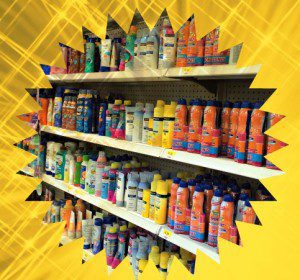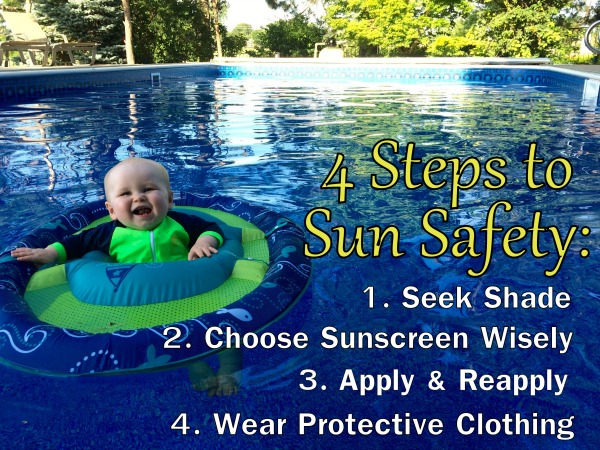Summer is an exciting time of year! The kids are out of school and the sun is shining bright. While it’s good to get out of the house and take advantage of the hot sunny weather, too much sun without proper precautions can cause serious damage to our skin.
I work in dermatology, so I see the detrimental effects of the sun on a daily basis. The vast majority of skin cancers I remove could have been prevented by practicing sun safety. It’s important for us as parents to teach our children how to protect their skin from the sun and to lead by example.
These 4 steps will help you and your family avoid sunburns, skin cancer, and premature aging.
1) Seek Shade
- The best way to avoid the adverse effects of the sun is to limit your time outside. This is especially important between the hours of 10 am and 2 pm when the sun’s rays are the strongest. Many experts recommend that if your shadow is shorter than you are, seek shade.
- Schedule outdoor activities in the early morning or evening instead.
- Avoiding the sun is especially important for babies. It’s advised to keep babies 6 months and younger out of the sun altogether.
- Use extra caution near water and sand as they reflect the damaging rays of the sun, which can increase your chance of getting a sunburn.
2) Choose Sunscreen Wisely
- Choosing a sunscreen can be overwhelming because there are so many options and the terminology is confusing! The type of sunscreen you choose is a matter of personal preference. Just make sure that your sunscreen meets the following criteria as recommended by the American Academy of Dermatology:

- Broad-spectrum protection, which protects against both UVA and UVB rays. Sunlight consists of 2 types of ultraviolet rays – ultraviolet A (UVA) and ultraviolet B (UVB). Getting too much of either can lead to skin damage and skin cancer, so you want a sunscreen that blocks both types.
- Sun Protection Factor (SPF) of 30 or higher. SPF of 30 blocks 97% of the sun’s rays. Higher number SPFs block slightly more, but there is no sunscreen that can block 100%. Higher SPF does NOT mean that you can stay in the sun longer! Regardless of SPF, sunscreens last the same amount of time and should be applied roughly every 2 hours when outdoors.
- Water Resistant. These stay on your skin longer if you get wet. Keep in mind that no sunscreen is truly waterproof, so you still need to reapply after sweating, swimming, etc.
- If you choose a sunscreen in a spray form, do not spray near your face to avoid inhalation. Instead, either use a separate product for your face or spray it on your hands and then rub it on your face.
- Ultimately the best sunscreen is one that you like and will use!
3) Apply and Reapply
- Sunscreen does not work instantly. Apply sunscreen to dry skin 15-30 minutes BEFORE going outdoors, even on cloudy days. Clouds only block up to 20% of UV rays.
- Use enough sunscreen to generously coat all skin that will not be covered by clothing. A general guideline is the “1 ounce” rule which dermatologists say is the amount needed to cover the exposed areas for most people. 1 ounce is roughly enough to fill a shot glass, which most of us can easily visualize. 😉
- Don’t forget about the ears, back of the neck, tops of hands, and the tops of feet which are often overlooked.
- Don’t neglect your lips either. Skin cancer can form on the lips, so apply a lip balm that contains sunscreen with an SPF of 30 or higher.
- Reapply sunscreen approximately every 2 hours or as directed on the bottle, even if you’re using a water-resistant sunscreen. You may need to apply more frequently after swimming or sweating heavily.
4) Wear Protective Clothing
- Cover up with tightly woven dry clothing. Not all clothing offers the same protection. In general, dark colors provide more protection than light colors and dry fabric is more protective than wet fabric.
- Some clothing is labeled with a UV Protection Factor (UPF) rating which indicates that it’s protective against UV rays. UPF is different from SPF. UPF specifies what fraction of the sun’s rays can penetrate through the fabric.
- For example, a shirt with a UPF of 50 allows only 1/50th of the sun’s rays to reach the skin. In other words, it blocks 98% of UV rays.
- Wear a wide-brimmed hat to help protect your face, head, ears, and neck.
- Wear sunglasses that block UV rays to protect your eyes.
Think about sun safety every day, not just when you’re going to the lake or pool. If you follow these 4 steps on a daily basis, your skin will thank you later!

















